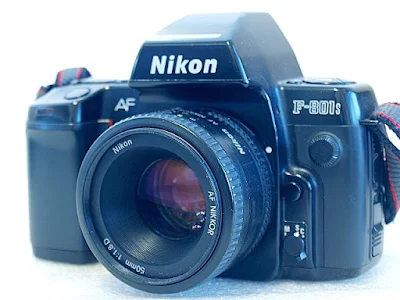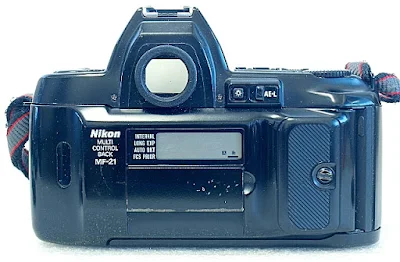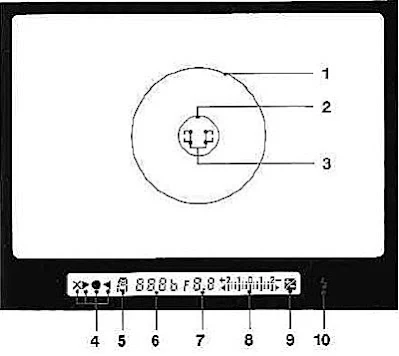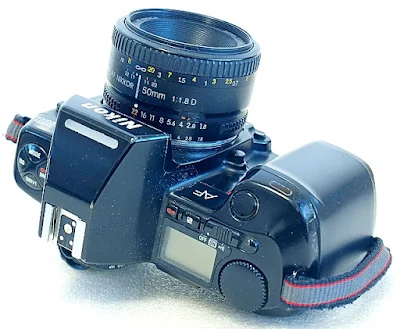The camera was an upgrade to the F-801 (N8008 in the US) and was produced between 1991 and 1995. While both siblings enjoy a reputation for extremely reliable performance and durability, the F-801s have improved autofocus performance and spot metering.
The F-801s are fitted with an electronically controlled vertical-travel focal-plane shutter with a speed range from 30 seconds to 1/8000-second, and B(ulb), with a flash sync speed of 1/250 seconds.
Metering range is from EV 0 to EV 21 (ISO 100, F1.4) for Evaluative 2D Matrix and 75% Center-Weighted Average, and EV 4 to EV 21 (at ISO 100) for Spot Metering. The camera accepts DX-coded films with an ISO speed range from 25 to 5000, while non-DX films can be manually set from ISO 6 to 6400.
Exposure modes are PASM - Programmed Automatic with P High (Program High - high-speed program option) and P (Program) modes, Aperture-Priority, Shutter-Priority, and Fully Manual. Film transport is motorized with settings for S (Single-frame), CH (Continuous High, approximately 3.3fps), or CL (Continuous Low, approximately 2.0fps in Continuous Servo-Autofocus or Manual mode). Rewinds automatically by button selection.
Stoner Camera Review: Nikon N8008S aka F801 Episode 1
A high and mighty review of the Nikon N8008s / F801. Stoners welcome to comment and check out! Follow me on instagram @ stonercamerareview
The F-801s are also fitted with an electronically-controlled 2 to 30 seconds delay and a 'Two-Shots' Self-Timer, DoF (Depth-of-Field) preview, Multiple Exposure with a capability of up to nine shots on a single frame, and compatibility with the Nikon Multi-Control Back MF-21 for freeze-focus shooting, data imprinting, and automatic exposure bracketing. The F-801s are powered by a set of four (4) AA-type batteries.
Basic Camera Features
The F-801 series camera, despite being designated as an amateur model by Nikon's 3-digit nomenclature, is actually an advanced semi-professional model. When released in 1988, Nikon ranked it just below the F90/F90s (N90/N90s) models.On the front plane of the camera, between the raised lens housing mount and molded hand-grip, are the DoF (Depth of Field) preview, and lower down on the corner, are the AF-L (Auto Focus Lock) buttons. On the right of the mount are the Flash Sync socket, Lens Release Lock, and Focus Mode Selector button.
On the top plane, set right to the left edge, is a 4-button clover-leaf pad for Mode (for Program, Shutter Priority, Aperture Priority, and Manual), ISO (when DX-coded film is loaded, the camera automatically sets the ISO rating), Drive (for continuous or single frame) selections, and ME/Rewind.
To the top-right corner of the pad is the Metering System toggle, and on the lower-right, the Self-Timer toggle switch.
To the right of the pentaprism hump, which has a hot shoe installed, from front to back, are the Shutter Release button located on the top-left edge of the hand-grip, a pair of grouped pair of toggle button switches for Film Rewind and Exposure Compensation, a three-position Power On/Off/Audio slide switch, LCD panel, and Command Input Control Dial.
On the back, from left to right along the back of the top plane are the Viewfinder Eyepiece, Viewfinder/LCD Illumination button, and AE-L (Auto Exposure Lock) lever.
The interchangeable hinged film back, opened via a double slide latch release located on the left shoulder of the camera body, comes with a film cartridge confirmation window, and if fitted with the MB-21 back, an LCD panel and switches for QD (Quartz Date) functions, and a screw-in panel cover for the QD panel batteries.
Located on the bottom plate are the battery holder cover and tripod socket.
The film box of the F-801s is similar to what is seen on SLR film cameras, with the DX-enabled film canister chamber located on the far left, followed by the shutter window, forward sprocket gear, and take-up spool. Film forward, however, is automatic. The film tab is extended to the red mark on the spool side of the film back and tensioned before the film back is closed.
Film Loading and Rewinding
Film loading is the standard manual procedure of opening the film back, placing the film canister into the DX-pinned chamber, pulling the film tab across the shutter window to the red dot mark, aligning the perforation on the film's edge to the sprocket gear, and checking that the film is properly tensioned before closing the film back. Release the shutter, and the film will be forwarded to Frame 1 automatically.The film advance stops automatically at the end of the roll. To rewind, press the two red-colored rewind icons, one located on the cloverleaf selector dial on the left of the camera top, and the other located above the LCD display on the right of the camera top, simultaneously.
Viewfinder Readout
The viewfinder readout is set with the following:
- 12 mm diameter circle for Center-Weighted metering
- 3.5 mm diameter circle for Spot Metering
- Focus brackets
- Focus indicators
- Exposure mode
- Shutter/Film speed
- Aperture/Exposure compensation value
- Electronic Analog Display
- Exposure compensation mark
- Flash-ready LED
LCD Panel Display
- Exposure modes (PD, A, S, M, PH, P)
- Exposure Metering System (Matrix, Center-Weighted, Spot)
- Exposure Compensation
- Electronic Analog Display
- Shutter speeds
- Aperture setting
- Self-Timer
- Film speed setting
- DX-coded film speed setting
- Film advance mode
- Film installation
- Film advance and rewind
- Multiple exposures
- Frame counter
Buttons, Sliders, and Switches
While the array of buttons, sliders, and switches to manage and control the camera may look rather complex in the beginning, operating the camera is simple, straightforward, and logical. You will get the hang of it in no time. Program mode changes, the shift from P to A, to S, or M, is done by pressing the MODE button on the clover-leaf pad and jiggling the Command Input Controller, or in simpler terms, the control dial located on the far right of the top plate.Press the same button on the clover-pad and jog the control dial to make manual changes to film ISO setting, and DRIVE mode, while pressing the ME button gives you the option of setting the multiple exposure values from 2 to 9. Pressing the same button again, but in tandem with the rewind icon button on the opposite side of the top plane, will set the film rewind rolling.
Pressing the small Metering System Selection or the Self-Timer buttons located on either the top-right or bottom-right corner of the clover-leaf pad will let you toggle the options of the same, with the setting displayed again on the LCD panel. Last, on the top plane of the camera, there is just the Exposure Compensation button to look at, and on the back of the top plane, the AE-Lock button.
Exposure Compensation is +/- 5EV in 1/3EV steps, and the exposure reading of the image frame is locked once the AE-lock button is pushed and held.
As already mentioned, all basic controls except for Auto-Bracketing and Flash Exposure Compensation are available on the camera. Auto-bracketing is an option available with the interchangeable MF-21 back (together with freeze-focus shooting, and data imprinting), and Flash Exposure Compensation is a setting for the flash (If the flash doesn't support it, use manual ISO changes instead).
When mounted with Nikon dedicated speed lights, a flash-ready setting is displayed by LED lights in the viewfinder display.
Lens Compatibility
The F-801s are broadly compatible with most Nikon AI and AF F-mount lenses, with restrictions depending on the lens type. All features are available when used with AF-type lenses. Non-CPU (AI and AI-S) lenses are supported, but only Manual and Aperture-Priority exposure programs are available, using center-weighted metering.Autofocus is not supported with AF-I and AF-S lenses, and Vibration Reduction (VR) is not available regardless of the lens. Newer G-type lenses are usable with the Program and Shutter-Priority exposure programs (though it is possible to use them in Manual or Aperture-Priority programs, only at minimum aperture).
Battery
The F-801s require the use of a set of 4xAA batteries to power their operations. Under normal operating conditions, the cells can power the camera for up to (manufacturer's claim) 105 (Alkaline), 75 (rechargeable NiCd), or 25 (Manganese) 36-exposure film rolls. Under cold weather conditions, the number of film rolls per set of batteries will decrease exponentially.Camera Body Weight
The F-801s are comparatively heavy at 695 grams without batteries.The Pitch
On the off chance that you are really looking at the choices of film cameras to kick start your interest in film photography, or to go back into (if you are a digital photo enthusiast), I am one of the guys who will say that vintage manual focus cameras of the '70s may not actually be the best choice for you.I am recommending, instead, AF (autofocus) 35mm SLR film cameras from the '90s, or specifically, an AF SLR camera that was introduced about the time digital SLRs began to take root, best with the same make and brand of AF lenses you may already have.
This is for the simple reason that these breeds of cameras are advanced with their AF technology and normally come with full PASM shooting modes, advanced metering systems, and features close to what you already have on your current digital SLRs or ILCs.
With these cameras, you will still be able to learn all the things you need to know about film photography, say, learning about the exposure triangle or exposure compensation, and to top it all, you will always end up with images that are perfectly exposed with a tack-sharp focus for each and every frame.





















Very informative and practical advice about the nikon 801.
ReplyDeleteThank you.
DeleteNikon F-801 was released in the summer of 1988. I was excited to get one as it was the first decent Nikon SLR with USABLE AF. My excitement turned into disappointment when Nikon F4 came out later that year. I got the F4 eventually, but found myself using the F-801, and later also the F-801s, much more often than the beast. One gets nearly identical functionality in a smaller and much lighter package. I still have my original body - it's worn beyond recognition, but works perfectly. imho, this and the F100 are the very best AF Nikon film bodies for those who use cameras for photography (as opposed to fashion accessories, status symbols, or collectibles). F4/F5 were too heavy and the F90, despite its similarities to the F-801, was a disaster at many levels.
ReplyDeleteOut of curiosity, why was the F90, "a disaster in many levels"?
DeleteTo each, his own.
Delete